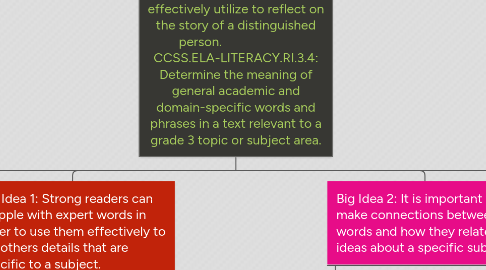
1. Big Idea 1: Strong readers can grapple with expert words in order to use them effectively to tell others details that are specific to a subject.
1.1. Student need for scaffolding: Given the bilingual learning setting, many students may struggle to employ words using the right syntax or grammar.
1.1.1. Strategy: Prior knowledge with a partner think-pair-share
1.1.2. Activity: Students work with partners to share a reflection on what they have learned about a distinguished person during research. Partner 1 will tell Partner 2 three words or phrases that they will use from the expert word wall. Partner 2 writes down the words. Then Partner 1 uses the three words to talk about the distinguished person. Partner 2 tells Partner 1 if what they said sounded like it made sense or if there was a more clear way to say something.
1.1.2.1. Further differentiation: For students who may struggle to work with partners or to focus with others, students will be asked to right down a list of ten words/phrases they might like to use before working with their partner. Having the students pre-select their words can help prime them for the task. As well, by creating the list of words for their partner, Ss can help to organize their partner work in advance.
2. Big Idea 2: It is important to make connections between words and how they relate to ideas about a specific subject.
2.1. Student need for scaffolding: As students construct their knowledge about a new subject, they are grappling with the new vocabulary and the details. In the bilingual setting, simultaneously recalling new vocabulary and organizing details can be especially challenging.
2.1.1. Strategy: Pause. Ask questions. Pause. Review.
2.1.2. Activity: Students will collaborate to stretch their knowledge about a distinguished person in order to help them organize their ideas. The teacher will provide a model with a student partner. Partner 1 will look at the word wall, choose a term/phrase, make a sentence using it and then pause. Partner 2 will ask a question that helps to stretch the idea from Partner 1's sentence. Partner 2 will tell what they can to stretch what they said and if they can not, then Partner 2 can help. Finally, Partner 2 reviews what Partner 1 has said.
2.2. Further differentiation: Students record what they are saying using the PhotoBooth software on their Mac Computers. Students will play back the procedure to determine A) Whether what they each said made sense or B) If they can stretch the idea more given what they reviewed. This additional scaffold can support language development, accountability, attention, diverse leearning interests, and high order thinking skills (determing, judging, and evaluating the accuracy and meaning of their words in contect). This additional scaffold can support students at all levels.
3. Big Idea 1: Strong readers can grapple with expert words in order to use them effectively to tell others details that are specific to a subject.
3.1. Student need for scaffolding: Given that the expert word wall was created by many students, some words and phrases may still remain unknown to others.
3.1.1. Strategy: Pre-teach vocabulary with a model, fishbowl, and practice
3.1.2. Activity: Before asking students to use the vocabulary to create a product, the teacher uses two pre-teaching formats to help students refresh, review, or learn words that are on the word wall. 1) The teacher shows the students how to use pictures and paragraphs from their research texts to help them use the vocabulary. For example, the word "awl" is a sharp tool that Louis Braille poked his eye with and then went blind. The teacher points to the awl and explains why the awl is important to Louis Braille's story. The teacher models several more examples and then calls a group to the center. 2) In a fishbowl, students show how they can take turns using pictures to help remember and use the vocabulary.
3.1.2.1. Further differentiation: Above grade level students can be asked to hunt for places in the text where the terms/phrases appear. (They can also use chapter books rather than picture books.) After locating the words in context, they can take on the challenge of rephrasing the text in their own words, but still using the selected vocabulary.
4. Big Idea 2: It is important to make connections between words and how they relate to ideas about a specific subject.
4.1. Student need for scaffolding: Students may struggle to sequence historical details in a logical and clear manner.
4.1.1. Strategy: Sentence Structures/ Starters
4.1.2. Activity: Students will identify how they can fit vocabulary from the word wall into sentence starters. The sentence starters are organized to tell a sequence of events and/or details. For example, The (distinguished person) was known for ________. He/She struggled with __________. He/she wanted to _________.He/ She succeeded by ____________.
